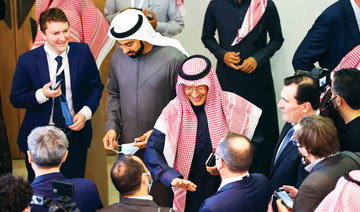LONDON: Speculation, according to Henry Ford, was a means of “making of money out of the manipulation of prices, instead of supplying goods and services”. His comment came to mind last week while watching the gyrations of the oil price.
At the start of last week, the market was abuzz with speculation that the US and Iran were close to resurrecting Tehran's 2015 nuclear deal with world powers. Speculation that the deal could be revived sent oil prices lower, despite geopolitical tensions in Ukraine. Then, a few days later, speculation that a deal was less likely helped drive the price of oil to a seven-year high.
A rapprochement on the nuclear deal, which former US President Donald Trump abruptly abandoned in 2018, would remove sanctions on Iranian oil exports, potentially offering some relief to an increasingly tight market.
An agreement between the US and Iran, which could potentially add 1 million-plus barrels per day (bpd) to the market, could go some way towards cooling the seemingly unstoppable rise of black gold to $100 (SR375).
Thus, the flurry of diplomacy in Vienna, where diplomats from the US, Europe, Russia, China and Tehran are meeting, is being as closely watched by oil markets as Vladimir Putin rattles his saber in Ukraine.
However, notwithstanding the latest, hopefully better, news from eastern Europe or indeed what’s happening in Vienna, like Ford, we shouldn’t lose sight of the fundamentals.
The price of a barrel of Brent jumped 50 percent last year as post-pandemic demand strained supply. Since January, Brent crude has risen 20 percent and is hurtling at pace towards the magic triple-digit of $100 per barrel.
Tensions in eastern Europe, or between Washington and Tehran, may ease, but the current supply-demand imbalance in oil markets will not.
It’s worth noting that despite sanctions, Iranian oil exports have risen to more than 1 million bpd for the first time in almost three years, almost entirely through increased shipments to China.
Iranian oil minister Javad Owji recently said Tehran’s production is now close to the level it was before Washington’s withdrawal from the nuclear deal.
But don’t just take his word for it. An OPEC report this month estimated Iranian crude output for 2021 averaged 2.4 million bpd, a sharp increase on the previous year’s 1.9 million bpd.
That said, Iran's output averaged 3.8 million bpd in 2017, and its current illicit exports fall far short of the 2.5 million barrels Tehran shipped before the nuclear deal fell apart and sanctions hit its economy.
Those who think the reintroduction of Iranian oil can make a difference point to the fact that it’s been obvious for months that OPEC and its allies are unable to increase supply. A recent BloombergNEF report reveals 15 of the 19 countries with output targets failed to meet them in January, with production from OPEC increasing by just 65,000 bpd last month, a quarter of the scheduled rise. Moreover, increased instability in Libya, whose output remains at around half its pre-civil war levels, could see around 300,000 bpd wiped off global supply.
Against that backdrop, Iran looks best placed to be able to rapidly boost global supply by at least 700,000 bpd in the event sanctions are lifted.
But would that be enough to avert triple-digit oil this year?
Research group IHS Markit expects global oil demand to grow by between 3.8 million bpd and 4 million bpd from January to December.
Bear in mind that only Saudi Arabia and the United Arab Emirates appear to have significant amounts of spare production capacity, and neither appears to be in a rush to stem current prices, it doesn’t appear likely that unlocking Iranian oil will make much difference to oil’s direction of travel.
But is it likely sanctions on Iran will be lifted anytime soon?
Washington has suggested a deal is in sight. The danger, according to reports, is that Tehran’s continuing advances in its nuclear program mean the window for reaching an agreement is rapidly closing.
Last week, Iran's foreign affairs chief Hossein Amir Abdollahian said the US should stop indulging in "games" about deadlines. Instead, he reiterated Tehran’s demand that the US make a public apology for pulling out of the original deal, and a commitment that future administrations will be permanently bound by any new agreement.
Clearly, the US cannot commit to what a future President might be elected to do, but realistically, neither of these should be a deal breaker for Tehran.
Abdollahian would do well to remember that despite some low-level growth on the back of oil sales to China, sanctions have turned the Iranian economy into a basket case. The Iranian rial has collapsed, and is now worth half its 2018 value. Iranians are currently enduring 40 percent inflation, and banking restrictions caused by current sanctions leave the cost of most financial transactions prohibitively high, making both imports and exports more expensive. Iran also remains blacklisted by the Financial Action Task Force, the global money-laundering watchdog.
It is this reality that brought Tehran back to the negotiating table, along with US President Joe Biden’s desire to undo the damage unleashed by his predecessor to the original nuclear deal.
However, deal or no deal, oil is heading in one direction only. Bringing Iranian oil back to the market would certainly moderate price growth but would not stop it from breaking through the $100 barrier.


















